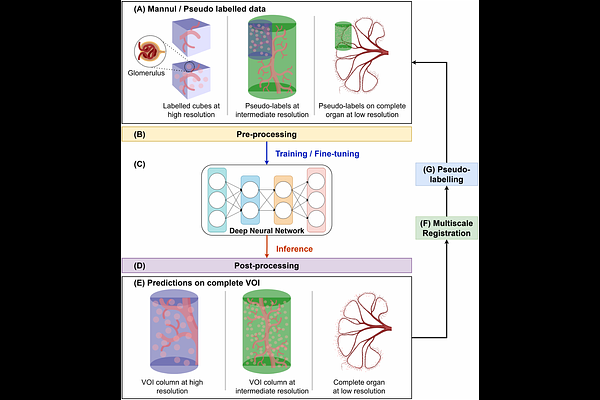Multiscale Segmentation using Hierarchical Phase-contrast Tomography and Deep Learning

Multiscale Segmentation using Hierarchical Phase-contrast Tomography and Deep Learning
Zhou, Y.; Aslani, S.; Javanmardi, Y.; Brunet, J.; Standsby, D.; Carroll, S.; Bellier, A.; Ackermann, M.; Tafforeau, P.; Lee, P. D.; Walsh, C. L.
AbstractBiomedical systems span multiple spatial scales, encompassing tiny functional units to entire organs. Interpreting these systems through image segmentation requires the effective propagation and integration of information across different scales. However, most existing segmentation methods are optimised for single-scale imaging modalities, limiting their ability to capture and analyse small functional units throughout complete human organs. To facilitate multi-scale biomedical image segmentation, we utilised Hierarchical Phase-Contrast Tomography (HiP-CT), an advanced imaging modality that can generate 3D multi-scale datasets from high-resolution regions of interest (ROIs) at ~2 m/voxel to whole-organ scans at ~20 m/voxel. Building on these hierarchical multi-scale datasets, we developed a deep learning-based segmentation pipeline that is initially trained on manually annotated high-resolution HiP-CT data and then extended to lower-resolution whole-organ scans using pseudo-labels generated from high-resolution predictions and multi-scale image registration. As a case study, we focused on glomeruli in human kidneys, evaluating four deep learning models for 3D biomedical segmentation on high-resolution data. Among them, nnUNet demonstrated the best performance and was subsequently used as the baseline model for multi-scale segmentation in the pipeline. Applying this model to full-organ low-resolution data enabled comprehensive morphological analyses, including cortical spatial statistics and glomerular distributions, which aligned well with previous anatomical studies. Our results highlight the effectiveness of the proposed pipeline for segmenting small functional units in multi-scale bioimaging datasets and suggest its broader applicability to other organ systems.